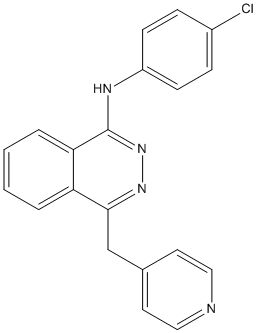
Vatalanib is an oral anti-angiogenesis agent that inhibits vascular endothelial growth factor receptor tyrosine kinases, which in patients showed auto induction of metabolism and variability in pharmacokinetic (PK) disposition. At higher concentrations, other tyrosine kinases are also inhibited, including PDGFR-β (IC₅₀ = 580 nM), c-KIT (IC₅₀ = 730 nM), FLT-4 (IC₅₀ = 660 nM) and c-FMS (IC₅₀ = 1.4 µM). On the other hand, vatalanib is not active against the EGFR, c-SRC, v-ABL, and protein kinase Cα (IC₅₀ > 10 µM). Vatalanib was well tolerated as a second-line therapy and resulted in favorable 6-month survival rate in patients with metastatic pancreatic cancer, compared with historic controls. The inhibitor Vatalanib is possibly an additional option in the treatment of leiomyosarcomas.
| Cell Experiment | |
|---|---|
| Cell lines | HUVECs |
| Preparation method | Endothelial Cell Proliferation Assays. As a test of the ability of PTK787/ZK 222584 to inhibit a functional response to VEGF, an endothelial cell proliferation assay, based on BrdUrd incorporation was used (Biotrak Cell Proliferation System V.2, Amersham, England). Subconfluent HUVECs were seeded at a density of 5 3 103 cells/well into 96-well plates coated with 1.5% gelatin and then incubated at 37°C and 5% CO2 in growth medium. After 24 h, growth medium was replaced by basal medium containing 1.5% FCS and a constant concentration of VEGF (50 ng/ml), bFGF (0.5 ng/ml), or FCS (5%), in the presence or absence of PTK787/ZK 222584. As a control, wells without growth factor were also included. After 24 h of incubation, BrdUrd labeling solution was added, and cells incubated an additional 24 h before fixation, blocking, and addition of peroxidase-labeled anti-BrdUrd antibody. Bound antibody was then detected using 3,395,59-tetramethylbenzidine substrate, which results in a colored reaction product that is quantified spectrophotometrically at 450 nm. |
| Concentrations | 0~1 μM |
| Incubation time | 24 h |
| Animal Experiment | |
|---|---|
| Animal models | Nude Mouse Human Tumor Xenograft Model |
| Formulation | distilled water |
| Dosages | 25 to 100 mg/kg once or twice dail |
| Administration | p.o. |
| Molecular Weight | 346.81 |
| Formula | C20H15ClN4 |
| CAS Number | 212141-54-3 |
| Solubility (25°C) | DMSO 25 mg/mL |
| Storage |
Powder -20°C 3 years ; 4°C 2 years In solvent -80°C 6 months ; -20°C 1 month |
| Species | Mouse | Rat | Rabbit | Guinea pig | Hamster | Dog |
| Weight (kg) | 0.02 | 0.15 | 1.8 | 0.4 | 0.08 | 10 |
| Body Surface Area (m2) | 0.007 | 0.025 | 0.15 | 0.05 | 0.02 | 0.5 |
| Km factor | 3 | 6 | 12 | 8 | 5 | 20 |
| Animal A (mg/kg) = Animal B (mg/kg) multiplied by | Animal B Km |
| Animal A Km |
For example, to modify the dose of Compound A used for a mouse (20 mg/kg) to a dose based on the BSA for a rat, multiply 20 mg/kg by the Km factor for a mouse and then divide by the Km factor for a rat. This calculation results in a rat equivalent dose for Compound A of 10 mg/kg.
| Related VEGFR/PDGFR Products |
|---|
| Isolinderalactone
Isolinderalactone suppresses human glioblastoma growth and angiogenic activity through the inhibition of VEGFR2 activation in endothelial cells. Isolinderalactone suppressed the expression of B-cell lymphoma 2 (BCL-2), as well as of survivin and X-linked inhibitor of apoptosis protein (XIAP). |
| Oglufanide
Oglufanide (H-Glu-Trp-OH) is a dipeptide immunomodulator isolated from calf thymus. |
| KLTWQELYQLKYKGI
KLTWQELYQLKYKGI (QK) is a VEGF mimicking peptide, binds to the VEGF receptors and competes with VEGF. |
| Protein LMWP
Protein LMWP is a cell-penetrating peptide with vascular endothelial growth factor (VEGF) inhibitory activity. |
| CBO-P11
CBO-P11 specifically binds to receptor of VEGFR-2 and is used as targeting ligand for tumor angiogenesis. |


Products are for research use only. Not for human use. We do not sell to patients.
© Copyright 2010-2023 AbMole BioScience. All Rights Reserved.
